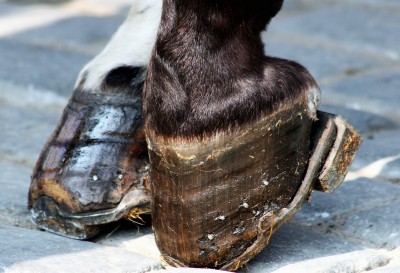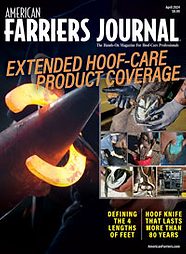 Suddenly your horse is lame. You wrack your brain trying to determine why; perhaps it’s a stone bruise, maybe the farrier has some insight, or maybe your horse needs chiropractic care. Once you’ve found no solution in those areas, you decide to call in the veterinarian. A simple lameness exam and flexion test can give you some insight into why your horse is lame. Finally, radiographs confirm what your vet suspects as the issue: navicular disease.
Suddenly your horse is lame. You wrack your brain trying to determine why; perhaps it’s a stone bruise, maybe the farrier has some insight, or maybe your horse needs chiropractic care. Once you’ve found no solution in those areas, you decide to call in the veterinarian. A simple lameness exam and flexion test can give you some insight into why your horse is lame. Finally, radiographs confirm what your vet suspects as the issue: navicular disease.
Navicular disease is the name given to the pain in the area of the navicular bone. It might involve inflammation of the navicular bursa, cartilage or tendon destruction, and bone changes. Pain may be mild or severe.
Many people think that equine navicular disease is a career ending diagnosis. However, that is not always the case. There are many horses that compete at high levels with navicular disease. Management and treatment are key in keeping your horse sound. Your two most critical people in your horse’s care will be your veterinarian and farrier. Make sure they are working together to care for your horse.
Often times, the first course of action is to use corrective shoeing. Once your veterinarian and your farrier connect, they can determine what the best corrective shoe for your horse is. Likely changing the hoof angles is the first step. This can be done through using bar shoes or wedges.
Additionally, medicinal therapy also can be used. This can be through injections or using bisphosphonates. This is where your veterinarian comes in.
Although this therapy can be pricey, it often can be quite successful. You must have a conversation with your veterinarian about what your budget is for maintenance on your horse. Be realistic and honest about your ability to financially manage the gamut of treatments that are available for your horse.
Learn More
• Gaining A Clearer Picture Of Navicular Problems
• Diagnosing Issues With The Navicular Apparatus
• Maintaining Soundness With The Navicular Horse
Michigan State University Extension suggests the best thing you can do is be aware and get educated. No one knows your horse like you do — you know what is normal for them, when they are acting a little “off,” and when there is something definitely wrong. Keeping records of treatments, when your horse is sore or lame, when he is not, and what you have been doing with him will give insight as to how to best manage your horse. Furthermore, educate yourself about treatments of navicular disease, therapies, proper exercise and overall horse health so that you can make educated decisions about your horse’s care and maintenance after they have been diagnosed.







Post a comment
Report Abusive Comment